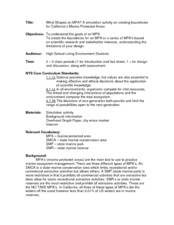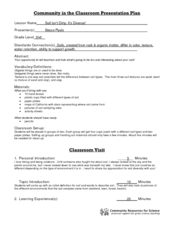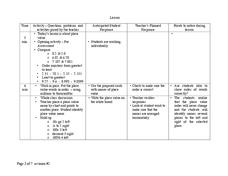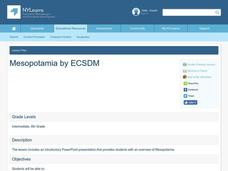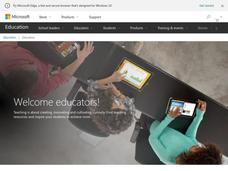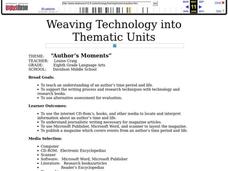Curated OER
Simulating the Greenhouse Effect in a Terrarium
Students identify what factors effect global warming and how the greenhouse effect occurs. In this environmental lesson students view videos then complete an experiment using a terrarium to observe greenhouse gas.
Curated OER
Global Warming
First graders discover the effects of global warming on polar bears. In this life science lesson, 1st graders model the polar bear's habitat and observe what happens as they raise the temperature. They record their observation in the...
Curated OER
Importance of Marine Protected Areas: an Overfishing Simulation
Young scholars simulate overfishing by conducting a guided experiment in the classroom. In this ecology lesson plan, students discuss the environmental consequences of overfishing. They research additional information about the issue and...
Curated OER
What Shapes a MPA?
Students identify the three types of MPA in California. In this marine science lesson plan, students analyze information provided to design a new MPA. They justify their reasoning in class.
Curated OER
Marine Life Protected Areas in the O.C.
Students research a Marine Protected Area and determine the species' that benefit from its protection. In this marine lesson students present their findings to the class using PowerPoint.
Curated OER
The Tobacco Time Bomb: What's In A Cigarette?
In this enlightening and disturbing health lesson, students read and discuss information on smoking and closely-look at the ingredients in a cigarette. You will be amazed at the list of ingredients that are found in cigarettes. This...
Curated OER
Adding Integers with Counters
Students add integers and use counters to create a visual. In this algebra lesson, students work in pairs as they use the computer to add integers. They complete an assessment on adding integers at the end of the activity.
Curated OER
Simple Harmonic Motion with Dr. DAQ
Young scholars study the work and accomplishment of Galileo. In this physics lesson, students calculate the period of a pendulum's using a mathematical equation. They explain the different factors affecting its period.
Curated OER
Soil Isn't Dirty; It's Diverse!
Second graders participate in a soil activity. In this soil instructional activity students complete a worksheet describing different soil types and the organic and inorganic things found in them.
Curated OER
Snap Associations
Pupils practice reinforcing and recycling a large amount of vocabulary terms by utilizing a set of pictures and then dividing into groups to begin their task for the day. They explain the connections to each other between their terms and...
Curated OER
Fun with Fossils
Second graders explore the geologic process of fossil formation. In this geology lesson plan, 2nd graders discuss the job of a paleontologist and make their own model of a fossil. This lesson plan includes teacher directed questions.
Curated OER
Getting the Dirt on Soils
Students examine soils and the components that make them up. In this hands-on soil science lesson, students receive soil samples and must identify the various aspect which make up soil.
Curated OER
Place Value
Practice place value skills with this lesson. Learners put numbers in order from greatest to least, identify the values of particular numbers, and engage in an activity to compare numbers using manipulatives.
Curated OER
What Makes Thing Fly?
Second graders study lift, drag and thrust from a real flight instructor. In this physical science lesson students build and fly paper airplanes and experiment with variations and design.
Curated OER
The Differences Between Turtles and Tortoises
First graders differentiate between turtles and tortoises. In this turtles and tortoises lesson students are visited by a turtle and a tortoise. Students write a letter with an illustration after the animals visit the class.
Curated OER
Things That Glow: From Fireflies to Quantum Dots
Third graders observe light energy. For this heat and energy lesson, 3rd graders will study the concept of light as a form of energy. Students will examine the different forms of light and the type of energy it produces.
Curated OER
Mesopotamia
Sixth graders describe the geography of Mesopotamia, explain the characteristics of Sumerian city-states, and identify the cultural practices of the ancient Sumerians. They then explain how empires formed in Mesopotamia.
Curated OER
Use synonyms to make your writing vivid
Students examine synonyms and practice finding appropriate synonyms in a thesaurus. For this use synonyms to make your writing vivid lesson, students identify the correct usage of synonyms. Students replace incorrect synonyms in...
Curated OER
Current Currencies
Pupils explore the nature of money and how foreign exchange rates work. They write reports based on their research.
Curated OER
Halloween Graphitti
Students complete multi-curricular activities in a Halloween themed lesson. In this Halloween lesson, students examine newspaper ads to find prices of pumpkins and use them to complete a stem and leaf plot. Students find the diameter,...
Curated OER
Plan A Trip Anywhere
Students role play being an international travel agent that is planning a trip for a client. The teacher gives specific details associated with the trip. They choose the destination and work out some of the other details. Students...
Curated OER
Organizing Writing/Composing a First Draft
Seventh graders access an organizer from an earlier lesson and transition sentences to begin a new essay. In this organization and composing lesson, 7th graders work in small groups to create a draft of an article about natural...
Curated OER
Habitat Mural
Students build a collage of an ecosystem. The goal is for them to understand interactions in a community, plant and animal adaptations, and how all life depends on plants. This activity is based on Wump World and students describe what...
Curated OER
Weaving Technology into Thematic Units
Eighth graders are taught to give an understanding of an author's time period and life.
Teachers support the writing process and research techniques with technology and research books. Alternative assessment is used for evaluation.





